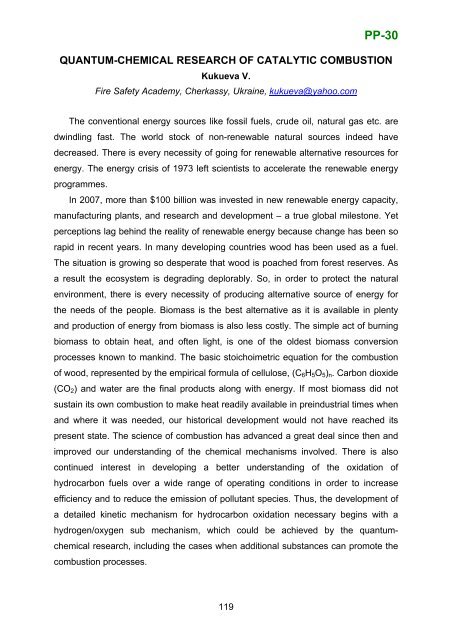Boreskov Institute of Catalysis SB RAS, Novosibirsk, Russia
Boreskov Institute of Catalysis SB RAS, Novosibirsk, Russia
Boreskov Institute of Catalysis SB RAS, Novosibirsk, Russia
- No tags were found...
Create successful ePaper yourself
Turn your PDF publications into a flip-book with our unique Google optimized e-Paper software.
PP-30QUANTUM-CHEMICAL RESEARCH OF CATALYTIC COMBUSTIONKukueva V.Fire Safety Academy, Cherkassy, Ukraine, kukueva@yahoo.comThe conventional energy sources like fossil fuels, crude oil, natural gas etc. aredwindling fast. The world stock <strong>of</strong> non-renewable natural sources indeed havedecreased. There is every necessity <strong>of</strong> going for renewable alternative resources forenergy. The energy crisis <strong>of</strong> 1973 left scientists to accelerate the renewable energyprogrammes.In 2007, more than $100 billion was invested in new renewable energy capacity,manufacturing plants, and research and development – a true global milestone. Yetperceptions lag behind the reality <strong>of</strong> renewable energy because change has been sorapid in recent years. In many developing countries wood has been used as a fuel.The situation is growing so desperate that wood is poached from forest reserves. Asa result the ecosystem is degrading deplorably. So, in order to protect the naturalenvironment, there is every necessity <strong>of</strong> producing alternative source <strong>of</strong> energy forthe needs <strong>of</strong> the people. Biomass is the best alternative as it is available in plentyand production <strong>of</strong> energy from biomass is also less costly. The simple act <strong>of</strong> burningbiomass to obtain heat, and <strong>of</strong>ten light, is one <strong>of</strong> the oldest biomass conversionprocesses known to mankind. The basic stoichoimetric equation for the combustion<strong>of</strong> wood, represented by the empirical formula <strong>of</strong> cellulose, (C 6 H 5 O 5 ) n . Carbon dioxide(CO 2 ) and water are the final products along with energy. If most biomass did notsustain its own combustion to make heat readily available in preindustrial times whenand where it was needed, our historical development would not have reached itspresent state. The science <strong>of</strong> combustion has advanced a great deal since then andimproved our understanding <strong>of</strong> the chemical mechanisms involved. There is alsocontinued interest in developing a better understanding <strong>of</strong> the oxidation <strong>of</strong>hydrocarbon fuels over a wide range <strong>of</strong> operating conditions in order to increaseefficiency and to reduce the emission <strong>of</strong> pollutant species. Thus, the development <strong>of</strong>a detailed kinetic mechanism for hydrocarbon oxidation necessary begins with ahydrogen/oxygen sub mechanism, which could be achieved by the quantumchemicalresearch, including the cases when additional substances can promote thecombustion processes.119
















